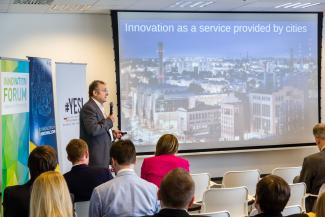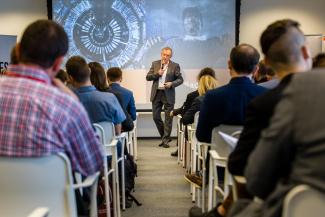He was the Vice President for Global Distribution Channel Strategy at IBM. This role included the development and application of the methods and processes used by the brands, known as Routes to Market, to reach and support customers via the network of 48,000 business partners. His team grew sales via distribution channels to over $4bn. He has conducted education roles in various universities including the Royal College of Art (London), Imperial College (London), Euncet Business School (Barcelona), Aalto University (Helsinki), University of Tampere (Tampere) and others.
Hello Nick, it’s great to see you in Lodz again. Thank you for agreeing to take part in this interview. Let’s start from a very clear question. Do you think that cities and city councils are spending money well on innovation?
Probably not; most of the resources needed for innovation are usually to be found somewhere in the city, but often they are hard to find. These resources include equipment, space, people – both to work in and with the startup, finance and knowledge of information sources, organizations and activities relevant to startups.
-
People includes competent people to work in the startup and subject matter experts, coaches and mentors to work with the startup.
-
Finance includes grants, loans and equity investment; angel networks, regional, national and local funding bodies and NGOs;
-
Knowledge includes market data: market size, growth rates, competitors; tools and methods for the management of startups and innovation projects; technologies, effective practices; structure of the local and national innovation eco-system.
Ok, so I understand that cities should work on communication and fast access to all resources available within its borders. This indeed is an amazing potential that could be revealed at small cost. It also agrees with Brad Feld’s claim that the main role of local authorities is to concentrate on removing barriers. The city cannot innovate on behalf of entrepreneurs, it can only help. Now let’s move to another actor on the scene: what should be the goal of university tech transfer offices?
I believe that universities play a very important role in the ecosystem. Their role could be summarized in several points:
-
To bring to market as quickly as possible the technologies that will have the most beneficial social, economic and environmental impact.
-
To create significant long term revenue for the university. I would define the share as “significant” if the percentage share of total annual revenue of the university is more than 10%.
-
To design and manage a motivating tech transfer journey that is easy to understand and follow.
-
To evaluate the effectiveness of the tools and methods they use for tech transfer.
-
To provide objective criteria for the identification, prioritization and selection of projects for tech transfer.
-
To communicate the benefits of tech transfer to all stakeholders in the university: faculty, professors, students, researchers, administration, parents of students, candidate students, local and national industry and subject matter experts, coaches, mentors and investors.
-
To develop and provide the tech transfer services needed by the stakeholders, including evaluation of the potential value of a project, intellectual property strategy, relationship management with stakeholders, including negotiation of licensing and investment, access to a pool of SMEs, coaches, mentors and investors.
-
To maintain knowledge about grants, loans, sources and types of investment and collaboration projects.
-
To share effective practices with the tech transfer community.
-
To minimize the ratio of cost to revenue in tech transfer.
This sounds like a very clear strategy for each university tech transfer office. Researchers and business people speak different languages and communication is crucial here as well as the design and quantification of the tech transfer journey. That’s fantastic! Thank you for such a precise answers. Now let’s move to the entrepreneur’s prespective which is in part 2.




